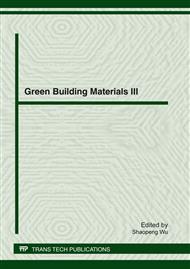[1]
Cui Y M, Wang H T. The applications of Titanium dioxide photocatalytic technology in the field of wastewater treatment[J].Water treatment technology, 2009, 35(4): 9-12.
Google Scholar
[2]
Wang D S.The applications of TiO2 photocatalytic in the field of wastewater treatment [J].J ournal of Fuyang Normal College(Natural Science),2008,25(3):49-52.
Google Scholar
[3]
LI A, Zhang Y Q, Li Y. The application of photocatalytic oxidation in treatment of organic wastewater [J].Anhui Agricultural Sciences,2009,37(8): 3706 -3707.
Google Scholar
[4]
Shi Y J. Treating tannery wastewater on nano-TiO2 photocatalytic oxidation [J].Chemical Environmental, 2006, 26(1):13-16.
Google Scholar
[5]
Bacsa R , Kiwi J , OhnoT , et al. Preparation , Testing and Characterization of S-doped TiO2 Active in the Peroxidation of Biomolecules Under Visible Light [J] . J Phys Chem B , 2005 , 109 (12) :5994-6003.
DOI: 10.1021/jp044979c
Google Scholar
[6]
Ohno T. Preparation of Visible Light Active S-doped TiO2 Photocatalysts and Their Photocatalytic Activities [J]. Water Sci Technol, 2004, 49 (4): 159-163.
DOI: 10.2166/wst.2004.0250
Google Scholar
[7]
Umebayashi T , Yamaki T , Tanaka S , et al. Visible Light-induced Degradation of Methylene Blue on S-doped TiO2 [J].Chem Lett., 2003, 32 (4) :330-331.
DOI: 10.1246/cl.2003.330
Google Scholar
[8]
Zhang L H, Liu L D, Chen Z C, Yu D Y. To synthesize N/S-doped TiO2 and its photocatalytic activity [J].Chemical Engineering,2008, 27(10):1610-1613.
Google Scholar
[9]
Wang Y P, Chao J L, Peng P Y. The form that S-doped affect to the structure and performance of TiO2-based photocatalyst[J].Journal of Inorganic Chemistry, 2009, 25(11): 2010-2015.
Google Scholar
[10]
Wang Z Y, Gao C M, Zhao B, Zu S N, Fan X P, Qian G D. The synthesis of S-TiO2 catalysts andtheirphotocatalytic properties [J]. Journal of Wuhan University of Technology, 2008, 30(7): 1-4.
Google Scholar
[11]
Liu S Y, Feng Q G, Tang W H, Jiang T Z. The solid-phase syntheses of S, Al-doped TiO2 nanomaterials and their degradation [J]. Journal of Inorganic Chemistry,2011,27(4):673-681.
Google Scholar
[12]
Liu S Y, Tang Q L, Feng Q G. Synthesis of S/Cr doped mesoporous TiO2 with high-active visible light degradation property via solid state reaction route [J]. Applied Surface Science, 2011, 257(13): 5544-5551.
DOI: 10.1016/j.apsusc.2011.01.033
Google Scholar
[13]
Zeng Y P, Zhang H S, Chen Z H. Handbook of modern chemistry reagents,fourth volumes [M].Beijing: Chemical Industry Press,1989.
Google Scholar


